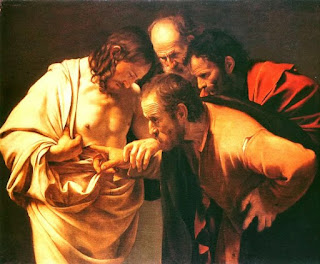Proof of Christ's Resurrection.
We continue along the 50 days of the
Easter Season, this week being the octave of eight days of Solemnities
celebrating the Easter Resurrection of the Lord.
This Sunday, the eighth day and Second
Sunday of Easter, is also Divine Mercy Sunday. The Opening Prayer (Collect)
says it all: “God of everlasting mercy, who in the very recurrence of the
paschal feast [Easter] kindle the faith of the people you have made your own,
increase, we pray, the grace you have bestowed, that all may grasp and rightly
understand in what font they have been washed [baptized], by whose Spirit they
have been reborn, by whose Blood they have been redeemed.”
Naturally, being eight days after Easter,
our Sunday Gospel reading is from John 20:19-31, relating when Jesus appeared
to the 11 disciples [minus Judas Iscariot] eight days after his resurrection.
In the Early Church, those who were called “Apostles” (“sent” ones) were
persons who had both seen the risen Christ and had been sent by him, given a
mission. So we see in these verses the qualifications of the 11 to be
“Apostles.” First, in verses 20-21, Jesus shows the 11 disciples his hands and
side, both pierced, in proof of his bodily resurrection. As God the Word took
on human flesh in the incarnation, now Jesus Christ continues as a human with a
physical body, but one that is now a changed, resurrected body (like the ones
we shall have).
Second, in verses 22-23, Jesus gives them
a new gift of the Holy Spirit accompanied by giving them, mere men, the power
to forgive, or not forgive, sins. Remember when Jesus told the paralytic that
his sins were forgiven, and the people said Jesus was blaspheming. “Who can
forgive sins but God alone?” Jesus said, “But that you may know [i.e., proof]
that the Son of Man has authority on earth to forgive sins,” he told the
paralytic to rise, and he did so. The healing miracle was Jesus’ proof that he,
the Divine and human “Son of Man,” had God’s authority to forgive sins on
earth. (Lk 5:20-26.) Now Jesus grants this same authority to his 11 Apostles.
The Church has always, from this eighth day after the resurrection and for 2000
years, understood that the same authority to forgive sins in Jesus Christ’s
name has been given to those who receive the charism of the Holy Spirit of
Apostolic Succession at their priestly ordination. If charisms of the Holy
Spirit for healings and miracles are experienced and believed, on what basis
should the charism of Apostolic Succession be doubted?
Perhaps a bit humorous in light of today’s
doubters of the priestly power to forgive sins, St. John immediately next
writes in his Gospel that “Doubting” Thomas now got his requested physical
proof of Jesus’ resurrection, as well as the grace of firm belief. Thomas then
declared to Jesus, “My Lord and my God!” (Jn 20:24-29.)
St. Cyril of Alexandria (375-444 AD) has some profound comments on the implications of this scene with Thomas. He writes, “Since all our expectation and the significance of our irrefutable faith, after the confession of the holy and consubstantial Trinity, centers in the mystery concerning the flesh, the blessed Evangelist [John] has very pertinently put this saying of Thomas side by side with the summary of what preceded. For observe that Thomas does not simply desire to see the Lord but looks for the marks of the nails, that is, the wounds on his body....
“With good reason, then, are we accustomed to have sacred meetings in churches on the eighth day [Sunday Mass].... Christ still visits us and appears to us all, both invisibly as God and visibly in the body. He allows us to touch his holy flesh and gives it to us. For through the grace of God we are admitted to partake of the blessed Eucharist, receiving Christ into our hands, to the intent that we may firmly believe that he did in truth raise up the temple of his body.... Let us, therefore, after touching Christ’s body, avoid all unbelief in him as utter ruin and rather be found well grounded in the full assurance of faith.” Amen.

